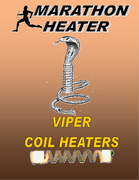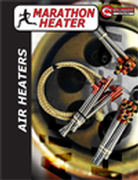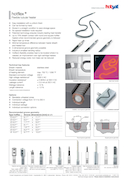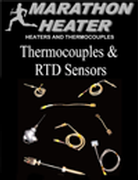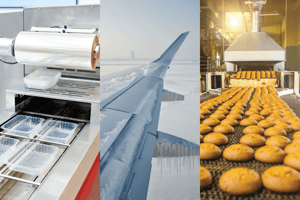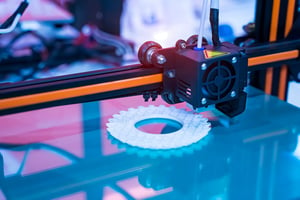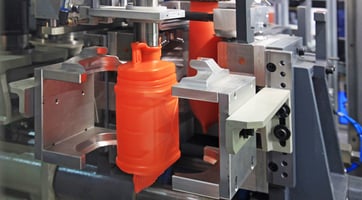Which Heater Is Right for Your Industry?
Heater Markets for the Plastics Industry
An Inside Look at Heaters for Packaging, Medical, and Recycling

Heaters play a crucial role in the plastics industry, helping to shape, mold, and recycle materials efficiently. Whether it’s ensuring even heat distribution for packaging, maintaining precise temperatures for medical applications, or improving energy efficiency in recycling, heating solutions are at the heart of many processes.
In this blog, we’ll take a closer look at how heaters impact these key sectors and see how they’re helping to make plastic production more efficient and sustainable. Whether you’re an industry professional or just curious about the technology behind plastics, we break it down in a simple, relatable way!
1. Heaters in the Packaging Industry
From heat sealers to hot knife cutters, heaters are the unsung heroes of the packaging world. They help maintain steady temperatures and keep everything running smoothly, whether it involves sealing plastic wraps or molding beverage or food containers. Each type of heater is designed for a specific job, ensuring precise temperature control and even heat distribution for top-quality packaging. No matter the application, the right heater makes all the difference in creating strong seals, clean cuts, and perfectly formed packaging.
We’ve written about the most common types of heaters in the packaging industry and where they’re used in our comprehensive resource page, available to read here.
Here’s a summary for quick reference:
- Heat sealers: Also known as heat seal machines or impulse sealers, they are used to seal various types of packaging materials, such as plastic bags, pouches, and films, by applying heat to melt the material together. They bond packaging materials together, creating airtight seals that protect products from contamination and spoilage. Heat sealers typically consist of a heating element, a sealing bar or jaw, and a pressure mechanism. Cartridge heaters and coil heaters are commonly employed in heat sealers to provide the precise heat required for sealing various packaging materials.
- Tray sealers: Used to seal pre-formed trays or containers typically made of materials such as plastic, aluminum, or foam. These sealers are commonly used in the food industry for packaging items typically for end-use consumers: ready-to-eat meals, fresh produce, and meat products, ensuring product freshness and extending shelf life. They work by sealing a film or lid onto the top of the tray to create a secure and tamper-evident package. Cartridge heaters are often employed in packaging tray sealers to provide the necessary heat for the sealing process to create secure seals around the edges of the trays.
- L-bar sealers: Commonly used for shrink-wrapping products, especially in the packaging of retail goods, food items, and industrial products, providing tamper-evident and protective packaging for retail display. They work by wrapping a film around a product or group of products and then sealing and shrinking the film to create a tight, protective package. Cartridge heaters are essential in L-bar sealers, as they provide the consistent heat necessary for sealing the film tightly and securely.
- Continuous band sealers: Used in packaging applications where a continuous sealing process is required—such as sealing bags or pouches filled with various products—used for items such as snacks, grains, or powders. These sealers are efficient for high-volume production settings to provide uniform heat sealing along the length of the packaging material. Cartridge heaters are utilized in continuous band sealers to provide the necessary heat for sealing the packaging material.
- Thermal cutting: Often used by packaging companies to precisely cut and seal packaging materials such as plastic films, bags, and pouches. Thermal cutting involves the use of heat to melt and seal the edges of the material, creating a clean and secure seal. Cartridge heaters are often employed in thermal cutting processes to provide the necessary heat for cutting and sealing.
- Hot knife cutting: This method is used by packaging companies to precisely cut through various types of synthetic nylon and polyethylene materials, including plastics, fabrics, and foams. These machines are equipped with a heated blade or knife that melts through the material, resulting in a clean and precise cut. Cartridge heaters are integral components of hot knife cutter machines, providing the heat necessary to heat up the blade to the required temperature for cutting.
- Thermal forming: This process is used to shape thermoplastic materials, such as plastic sheets, into desired shapes—such as trays, containers, or blister packs—by heating the material until it becomes pliable and then forming it over a mold or template. By providing the necessary heat to soften the thermoplastic material and facilitate accurate and uniform shaping of packaging materials, cartridge heaters demonstrate their importance in thermal forming processes.
2. Heaters in the Medical Industry
Silicone rubber heaters play a vital part in keeping patients safe and medical devices working efficiently. These flexible, lightweight heaters provide reliable and even heat distribution, making them perfect for applications where precise temperature control is essential.
Read about some of the key ways they are used in the medical field:
- Patient warming systems: Hospitals and surgical centers use heated blankets, warming pads, and incubators to maintain patients’ body temperatures during procedures and recovery. Silicone rubber heaters ensure that these warming systems provide consistent and controlled heat, helping to prevent complications such as hypothermia.
-
Fluid and IV warmers: When IV fluids, blood, or medications are too cold, they can cause discomfort or even pose health risks. Silicone rubber heaters are used in fluid warming by maintaining the optimal temperature and viscosity of medical fluids before administration to patients.
- Diagnostic and laboratory equipment: Many medical tests require stable temperatures to produce accurate results. Blood analyzers, DNA sequencers, and laboratory test chambers all rely on silicone rubber heaters to maintain precise heat levels, ensuring consistency in medical research and diagnostics.
-
Medical device manufacturing: Silicone rubber heaters are also used in the production of medical devices. They help in forming and curing medical-grade plastics, adhesives, and other materials used in healthcare products, ensuring quality and reliability in everything from prosthetics to surgical instruments.
-
Prosthetics and rehabilitation equipment: Custom prosthetic limbs and orthopedic devices often require heat during the shaping and molding process to ensure a perfect fit for patients. Silicone rubber heaters provide the flexibility and precision needed to create comfortable and functional rehabilitation equipment.
3. Heaters in the Recycling Industry
Heaters are critical to the recycling industry, helping to process plastic waste efficiently and turn it into reusable materials. From melting and reshaping plastic to maintaining the right conditions for grinding and pelletizing, heating solutions are essential for smooth operations.
Here’s how heaters are used in key recycling processes:
- Extrusion: Recycled plastic is melted and reshaped through an extrusion process to create new products or raw materials. Band heaters and cartridge heaters are commonly used to maintain consistent temperatures in extruder barrels and dies, ensuring smooth plastic flow and high-quality output.
- Grinding: Before plastics can be melted down, they need to be broken into smaller pieces. Some grinders and shredders use heated components to prevent plastic buildup, reduce moisture content, and improve the efficiency of the grinding process.
- Pelletizing: After plastic is melted and filtered, it is cooled and cut into small, uniform pellets for reuse in manufacturing. Heaters help control the temperature of cutting blades and die heads, ensuring that pellets form correctly without defects.
By maintaining precise temperature control, heaters improve efficiency, reduce energy waste, and help create high-quality recycled plastics. Sustainability continues to become a bigger priority around the world, and energy-efficient heating solutions are playing an increasingly important role in making plastic recycling more effective and eco-friendly.
By keeping the recycling process efficient and precise, heaters help reduce waste, save energy, and produce high-quality recycled plastic. As industries look for more eco-friendly solutions, heating technology is becoming even more important in making plastic recycling better for the planet!
Why Backer Marathon
Our loyal customers have come to know that we anticipate their needs because we actively search for solutions. This is reflected in our advanced quality planning (AQP) lens focused on all that we do. It allows us to be nimble, congruent, and efficient with processes and production. We and our customers benefit from this lean, lessons-learned perspective for each new—or existing—project we successfully execute.
Backer Marathon is part of the Backer North America Group, serving OEMs globally. Being linked with our sister companies under this umbrella provides a wide breadth and depth of resources, expertise, and experience that OEMs benefit from. We collaborate fully with our colleagues, and will source—and manage—the stock and unique custom-heating solutions you need.
We believe in hard work, creative engineering, and excellent customer service. Whether you need one piece or one thousand, Backer Marathon is committed to providing you with exactly what you need when you need it. As we innovate and lead the industry with unparalleled engineering and customer service, we look forward to helping you continue to grow with us.
Let’s talk about your next project. Contact us now or call us today at 1 (830) 775-1417. Nosotros hablamos español. We’re excited to collaborate with you.


